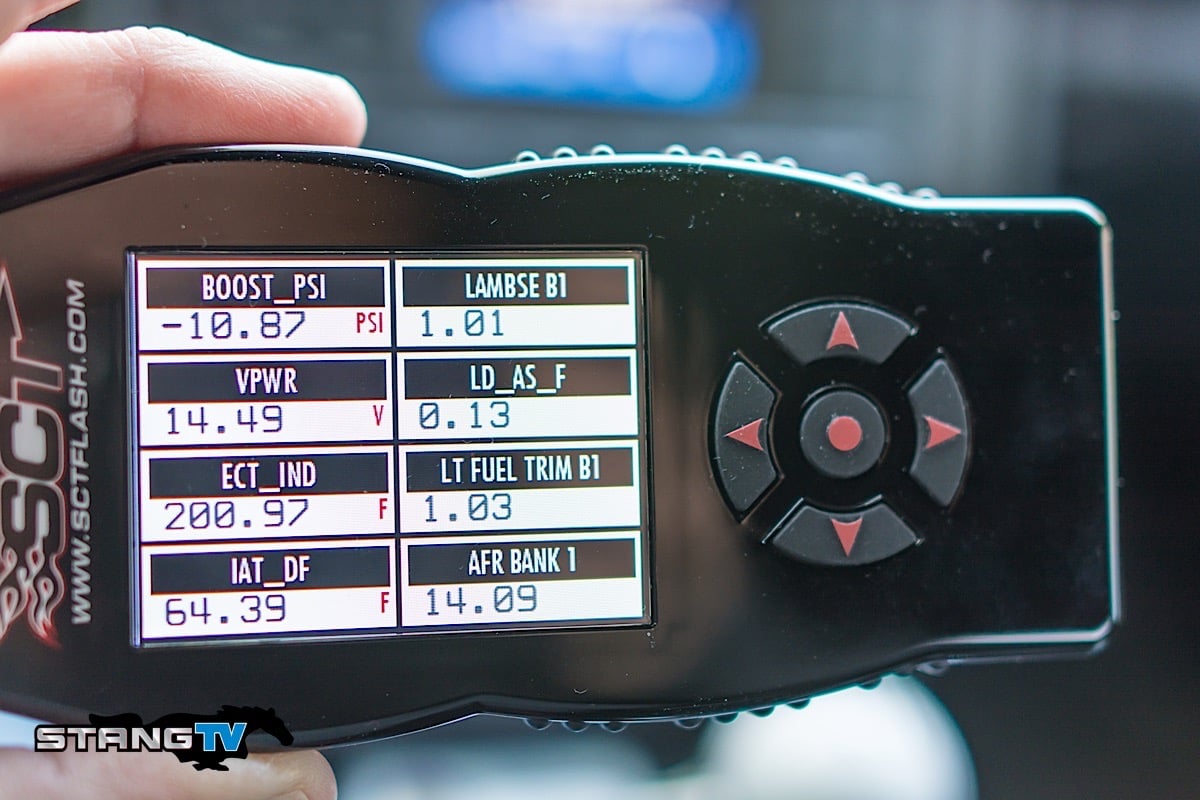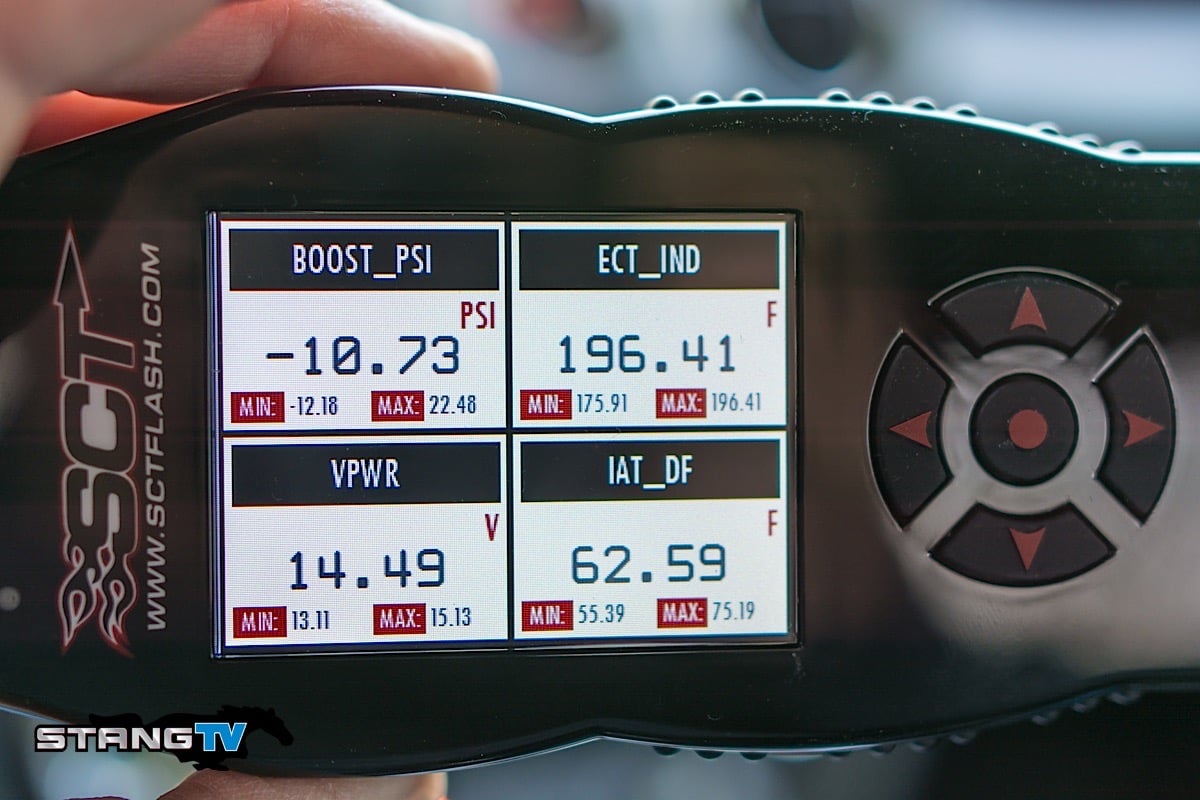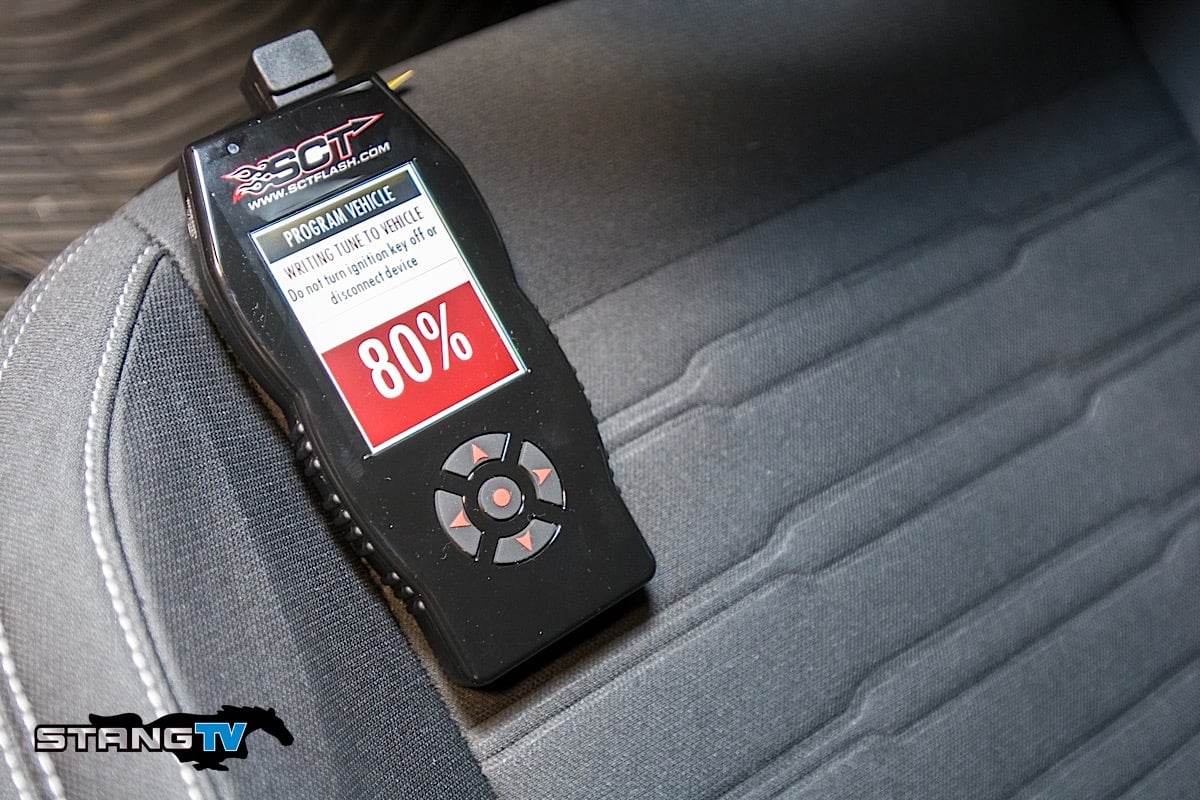 The EcoBoost engine is an all new platform for the Mustang beginning with the 2015 model year. While on the outside a 4-cylinder turbo engine sounds like heresy to many Mustang enthusiasts -there’s tremendous performance potential here. One of the most popular ways to maximize horsepower and unlock the engine’s potential is going to be with some EcoBoost tuning of the electronic variety.
The EcoBoost engine is an all new platform for the Mustang beginning with the 2015 model year. While on the outside a 4-cylinder turbo engine sounds like heresy to many Mustang enthusiasts -there’s tremendous performance potential here. One of the most popular ways to maximize horsepower and unlock the engine’s potential is going to be with some EcoBoost tuning of the electronic variety.
If you’ve been following along with our 2015 Mustang EcoBoost, Project 5-liter Eater, then you know we’ve set some pretty high standards for this car. To help maximize its performance in both this early stage, and as it progresses, we turned to the experts at SCT, for a X4 Powerflash handheld tuner part number 7015, these are now available from Jegs.com as part number 946-7015.

The X4 Powerflash is the latest and greatest product from SCT. This WiFi enabled tuner includes a USB cable, and OBD II compatible connector.
Hurdles To EcoBoost Power
It took 2-3 weeks for us to develop the tunes for the 2015 Mustang, and we had all hands on deck in the engineering department working on it. -Tim Roi, SCT
While peak boost on the stock car is a little late, there’s plenty of torque and rush as the boost builds, making the car fun to drive. When the peak power hits, the stock car will break the tires loose in first through third gears, often barking the tires going into third.
There are also a few other issues with the OEM computer calibration that lead us to wonder how much power some basic tuning could unlock on this car. One of the first things we noticed is that the throttle feels almost disconnected at times, especially under high boost. We’ve heard rumors that the OEM computer strategy only allows the throttle to open 40-percent under full boost.
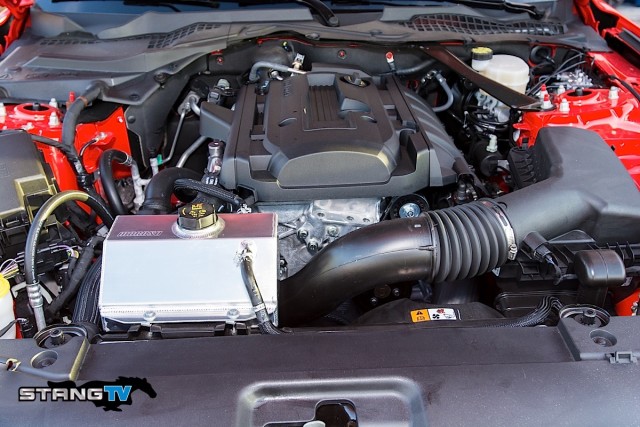
With the exception of a Moroso coolant reservoir upgrade, our 2015 Mustang EcoBoost was showroom stock when we headed to London Chassis Dyno to test it with the X4.
We have yet to gather the specs from Ford on the car’s fuel system. Given that we’ve seen several other EcoBoost Fords make big power using the stock fuel system components, we can’t help but assume that the Mustang’s fuel system will be able to compensate for some substantial upgrades.
Making EcoBoost Power
 According to SCT’s Tim Roi, “SCT was first to market with tuning for the 2015 Mustang, including EcoBoost, GT, and V6.” You may remember form our coverage of the 2014 NMRA World Finals, the SCT crew made the first drag strip passes ever with a 2015 Mustang GT in NMRA competition at that event. Those passes were made on Saturday, and by Monday, SCT’s entire engineering staff was working on the 2015 Mustang tuning program.
According to SCT’s Tim Roi, “SCT was first to market with tuning for the 2015 Mustang, including EcoBoost, GT, and V6.” You may remember form our coverage of the 2014 NMRA World Finals, the SCT crew made the first drag strip passes ever with a 2015 Mustang GT in NMRA competition at that event. Those passes were made on Saturday, and by Monday, SCT’s entire engineering staff was working on the 2015 Mustang tuning program.
Roi told us they took a similar approach to the 2015 EcoBoost Mustang, picking up a car at the dealership as quickly as they could locate one, and then bringing it to SCT headquarters in Florida to begin work. “It took 2-3 weeks for us to develop the tunes for the 2015 Mustang, and we had all hands on deck in the engineering department working on it”, says Roi.
X4 The Latest Evolution
The X4 is SCT’s latest handheld tuner and according to Roi was born out of the popularity of the X3 handheld unit. “The X3 was an incredibly popular tuner for us, and we took much of the feedback from our customers and used it to develop the X4” says Roi.
Out of the box, the X4 has a high quality appearance and feel. The color screen is a new feature, and is larger than the X3’s. The control buttons are also easily operated. The X4 is also wi-fi enabled. Wi-fi allows this tuner to communicate over any wireless network it can connect to, and download custom tunes. SCT’s cloud system is debuting this year, and we’ll be bringing you more about that as soon as it comes to market.
Alderman says that the included SCT tunes raise turbo boost pressure, alters the Ti-VCT strategy and wastegate tables among other things. “I worked with the wastegate table to keep boost stable and flat. Moving the Ti-VCT around for the intake and exhaust cams worked well to increase airflow. I also worked with the drive by wire system for enhanced drivability with torque requested tables.”
Alderman also says that automatic transmission cars benefit from additional enhancements, “Transmission enhancements to firm up shifts with pressure and reducing the amount of torque taken away (via torque management) during the shift.”
Working With Data
The X4 also has the ability to data log and display several different data points in real time as you’re driving the car. While our 2015 Mustang EcoBoost does display more data on the gauges and the information screen on the dash, being able to record this data, and read it vs the data on the gauges is beneficial. Having this data can be vital when tuning the car. This is especially true if a tuner is trying to nail down a specific problem, or solve an issue that isn’t occurring on the dyno, but only when the car is driving.
Boost monitoring is an excellent example of a discrepancy between what the gauge on the dash shows, and what is actually being read by our MAP sensor and sent to the computer -which is also what the X4 will display. After a recent round of modifications for an upcoming story, we noted the Performance Pack boost gauge read 26 psi. Driving the car on the road and using the datalogging function of the X4 we see that peak boost was just over 22 psi, even though the gauge continued to report 26 psi. If we were creating a custom tune for the car, this type of data would be extremely valuable.
The X4 allows you to monitor this real time data in a variety of different layouts. If your car wasn’t equipped with the Performance Pack, or there’s simply other data you’d like to watch more closely, you can use this function to do so.
Dyno Testing
I worked with the wastegate table to keep boost stable and flat. Moving the Ti-VCT around intake and exhaust cams worked well to increase airflow. I also worked the drive by wire system for enhanced drivability with torque requested tables. -Matt Alderman, SCT
Our baseline dyno test showed us 273.2 hp and 303.8 lb-ft of torque at the rear tires. We were pleased with those numbers, noting that by the factory power rating at the crank, we’re only losing about 12-percent of our horsepower through the drivetrain.
Analyzing the dyno graph, stock, our car made its peak horsepower right at 5,000 rpm. That power remains relatively flat until around 5,500 rpm, at which point it drops off sharply. Torque peaked at 4,667 rpm, but was relatively flat for the entire run.
We didn’t data log our boost pressure, but we’d suspect that peak torque came on when the OEM computer strategy allowed the turbo to start making steam. This is consistent with what we’ve noticed in street driving the car. Under full throttle, boost hangs out in the 10 psi range, jumps to 15 psi, until the engine reaches a specific RPM, and then peaks at 20 psi for 500-1,000 rpm, only to repeat this cycle when hitting the next gear.
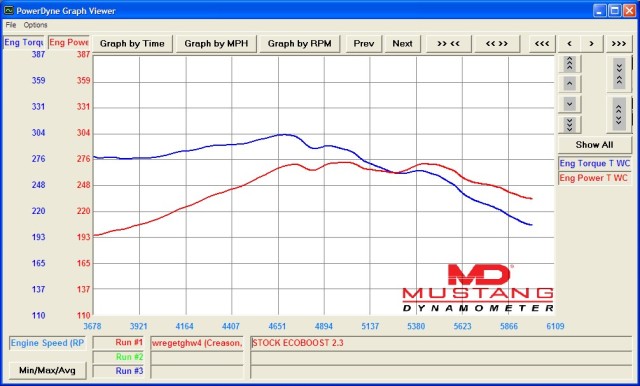
Stock, the little 2.3 liter managed to put down 273.2 hp and 303.8 lb-ft of torque to the rear tires.
With our baseline established, we put fans on the car, and again allowed it to cool for an hour while we loaded our SCT tune via the provided X4. 93 octane fuel is plentiful in Kentucky, and we’ve taken advantage of that with our project car, running it exclusively since we drove off the dealer lot in January. As such, we selected the supplied 93 octane tune and allowed the X4 to work its magic on the computer. This is the same 93 octane tune that SCT includes for any 2015 EcoBoost Mustang.
With our baseline established we loaded the included SCT 93 Octane Tune for our Mustang EcoBoost and allowed our car to cool down for about an hour.
We made a second dyno pull with our car, and monitored both our boost and air fuel ratio during the pull to see how the car responded. We immediately noticed a difference in the car’s accelerator pedal feel, and how quickly the engine responded to throttle input. Torque was nearly instantaneous, and the turbo spooled faster. In fact, as soon as we hit the throttle we saw boost rise quickly from 10 to 20 psi, and climb all the way to 25.
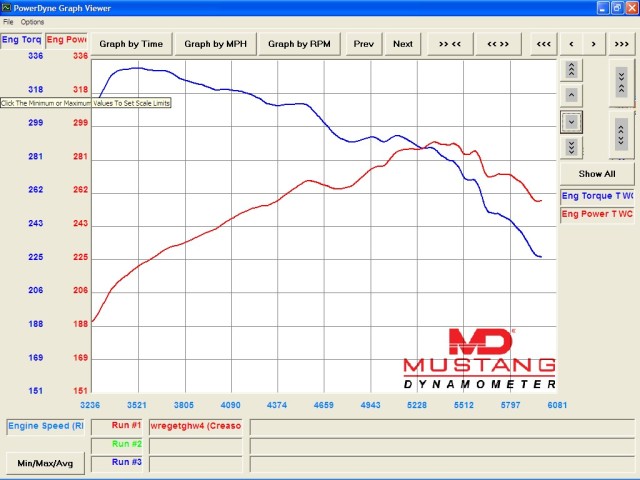
SCT didn’t let us down. With just the included 93 octane tune, we saw significant gains in horsepower, and huge gains in torque. Horsepower jumped to 291.8 at the rear wheels, while torque was closer to what we’d expect from a V8 Mustang, 339.9 lb-ft at the rear wheels. Those are gains of 18.6 hp, and 36.1 lb-ft, to the rear tires.
Looking at the data from the tuned dyno pull, we can see that SCT did not disappoint us. Our stock 2015 EcoBoost, with only the supplied 93 octane tune put down 291.8 hp at 5,468 rpm and 339.9 lb-ft of torque at 3,114 rpm, to the rear wheels. That’s a gain of 18.6 hp, and 36.1 lb-ft.
Closer inspection of the dyno sheet shows that our peak horsepower moved up by nearly 500 rpm. While this might sound detrimental, comparing it to the stock dyno graph we can see that we were surpassing the stock performance at 5,000 rpm by as much as 7 horsepower, and torque production was solid as soon as we put the pedal to the mat. At 3,600 rpm the engine has already picked up nearly 32 horsepower. Those kinds of gains continue throughout the RPM range, giving the car a tremendous amount of usable horsepower where it counts the most -the area where the engine spends most of its time.
What this means is that our car now has V8-like torque response, giving us virtually instant power on demand, and continues to make horsepower into a higher RPM range, giving us more room to run out the gears. We also have the RPM we need to run a lower, more aggressive rearend gear. While full throttle blasts are fun, having power where we can use it, throughout the operating range, is the desired outcome, and with this tune we get the best of both.
Test Drive
 On the street, the car is a different animal. Turbo lag is virtually gone, with boost, and the torque swell it creates rises like a rogue wave as soon as we mat the gas. Hitting the accelerator in any gear except sixth, we can break the tires loose, and this includes hitting it hard in fifth. We can feel the car’s stability control (ESC) kick in and scramble to keep the rear tires in check. If this car was fun to drive before, it’s a blast now, and we’re curious to get it on the drag strip and see what kind of times we can pull, and how many V8 owner hearts we can break.
On the street, the car is a different animal. Turbo lag is virtually gone, with boost, and the torque swell it creates rises like a rogue wave as soon as we mat the gas. Hitting the accelerator in any gear except sixth, we can break the tires loose, and this includes hitting it hard in fifth. We can feel the car’s stability control (ESC) kick in and scramble to keep the rear tires in check. If this car was fun to drive before, it’s a blast now, and we’re curious to get it on the drag strip and see what kind of times we can pull, and how many V8 owner hearts we can break.





